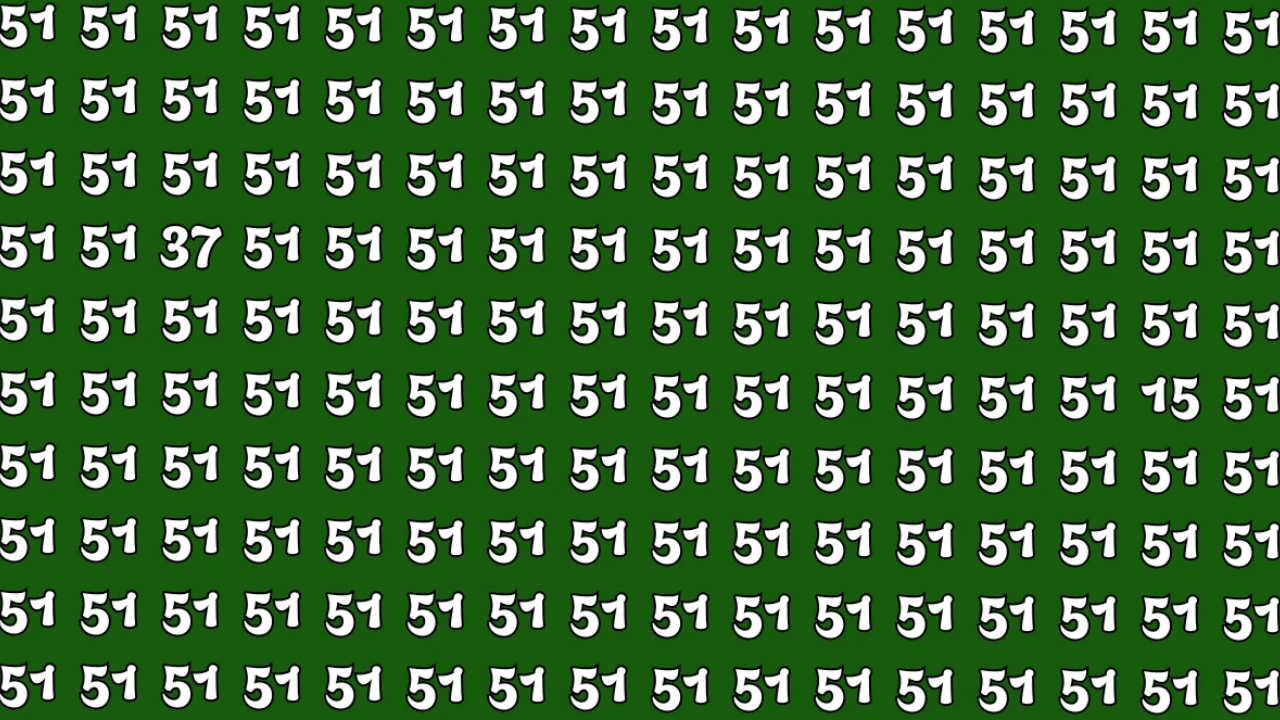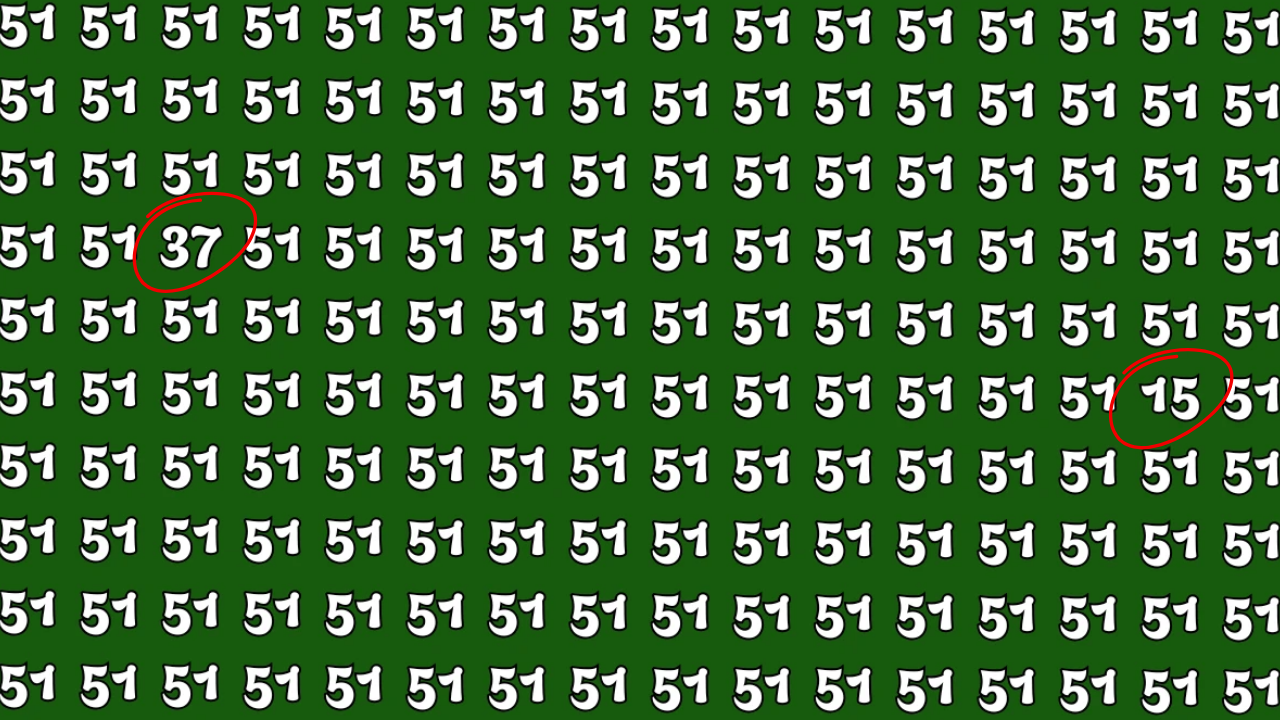Optical illusions are fascinating phenomena that challenge our perception and cognitive abilities. They trick the brain into seeing things that may not be present or perceiving objects differently than they actually are. These visual puzzles are not only entertaining but also serve as valuable tools for understanding how the human brain processes visual information. In this article, we explore a specific optical illusion challenge: spotting the numbers 15 and 37 hidden among a sea of 51s within just five seconds. This task tests your attention to detail, pattern recognition, and cognitive speed, making it a perfect exercise for sharpening your mental acuity.
Optical illusions have been studied for centuries, with scientists and psychologists delving into why our brains interpret certain images in unexpected ways. From ambiguous figures like the Rubin vase to motion illusions that make still images appear to move, these visual tricks captivate audiences worldwide. The challenge of finding hidden numbers, such as 15 and 37 among 51, taps into our brain’s ability to differentiate subtle differences in patterns, a skill rooted in evolutionary survival mechanisms.

The science behind optical illusions, explain how to approach the “spot the number” challenge, offer tips to improve your performance, and explore why these brain teasers are more than just fun games. Whether you’re a casual puzzle enthusiast or someone interested in cognitive science, this article will provide insights and strategies to master this optical illusion.
The Science Behind Optical Illusions
Optical illusions occur when our visual system misinterprets the information it receives from the eyes. The brain relies on patterns, context, and past experiences to make sense of visual stimuli, but illusions exploit these processes to create confusion. For instance, in the challenge of spotting 15 and 37 among 51, the repetition of the number 51 creates a visual “noise” that makes it harder to identify the outliers.
How the Brain Processes Visual Information
When you look at an image, light enters your eyes and is converted into electrical signals by the retina. These signals are sent to the brain’s visual cortex, which interprets them based on learned patterns and expectations. In the case of our optical illusion, the brain is bombarded with repeated instances of the number 51, which creates a sense of uniformity. The numbers 15 and 37, though present, are visually similar enough to blend into the background, making them difficult to spot within a short time frame like five seconds.
This phenomenon is tied to a concept called perceptual grouping, where the brain groups similar objects together to simplify processing. In the illusion, the repeated 51s form a dominant pattern, causing the brain to overlook the less frequent 15 and 37. Additionally, the time constraint of five seconds adds pressure, engaging the brain’s attentional spotlight, which determines what information is prioritized.
Cognitive Challenges in Spotting Hidden Numbers
The task of finding 15 and 37 among 51 is a test of selective attention—the ability to focus on specific stimuli while ignoring distractions. The brain must quickly scan the image, differentiate between numbers, and identify anomalies. This process is complicated by visual crowding, where closely packed objects (in this case, numbers) make it harder to distinguish individual elements.
Moreover, the similarity between the numbers plays a role. For example, the digits in 15 and 51 share visual features (like the number 5), and 37 and 51 both contain curved and straight lines, making them blend together at a glance. The brain’s tendency to “fill in the gaps” based on expectations can cause you to overlook the hidden numbers unless you actively focus.
The Optical Illusion Challenge: Spotting 15 and 37
Imagine a grid filled with the number 51 repeated dozens of times. Somewhere within this grid, the numbers 15 and 37 are hidden, and you have only five seconds to find them. This optical illusion is designed to be deceptively simple yet incredibly challenging. The uniformity of the number 51 creates a visual barrier, and the time limit forces you to rely on quick pattern recognition rather than methodical searching.
Why Is This Challenge So Hard?
-
Visual Similarity: The numbers 15, 37, and 51 share visual characteristics, such as similar digit shapes and lengths. This similarity makes it harder for the brain to distinguish them without close inspection.
-
Time Pressure: Five seconds is barely enough time to scan a large grid, let alone identify specific numbers. The brain must prioritize speed over accuracy, which can lead to mistakes.
-
Repetition Overload: The repeated 51s create a monotonous pattern that overwhelms the brain’s ability to pick out differences quickly.
-
Cognitive Load: The task requires you to hold the target numbers (15 and 37) in your working memory while scanning, adding to the mental effort.
How to Approach the Challenge
To succeed in spotting 15 and 37 within five seconds, you need a strategic approach. Here are some steps to follow:
-
Scan Systematically: Instead of looking at the grid as a whole, divide it into smaller sections. Focus on one quadrant at a time to reduce visual overload.
-
Look for Distinct Features: The number 15 has a unique combination of a straight line (1) and a curved line (5), while 37 features a sharp angle (3) and a rounded digit (7). Train your eyes to spot these shapes rather than reading each number.
-
Use Peripheral Vision: Sometimes, anomalies stand out more when you don’t focus directly on them. Let your peripheral vision catch differences in the pattern.
-
Practice Pattern Breaking: Familiarize yourself with the number 51’s appearance, then actively look for numbers that break this pattern.
-
Stay Calm: Time pressure can cause panic, which impairs focus. Take a deep breath and trust your brain’s ability to spot differences.
Tips to Improve Your Optical Illusion Skills
Mastering optical illusions like this one requires practice and cognitive training. Here are some tips to enhance your ability to spot hidden numbers and tackle similar challenges:
1. Train Your Attention
Engage in exercises that improve selective attention, such as playing “spot the difference” games or practicing mindfulness meditation. These activities strengthen your ability to focus on specific details while ignoring distractions.
2. Practice Visual Scanning
Games like word searches or hidden object puzzles can improve your ability to scan complex images quickly. Try timing yourself to build speed without sacrificing accuracy.
3. Learn to Recognize Patterns
Familiarize yourself with common patterns in optical illusions, such as repeated shapes or colors. The more you practice, the better you’ll become at spotting anomalies.
4. Take Breaks
Staring at an optical illusion for too long can cause visual fatigue, making it harder to spot differences. Take short breaks to reset your brain and return with fresh eyes.
5. Use Technology
Some optical illusion apps and websites offer timed challenges to help you practice. These tools can simulate the pressure of a five-second limit and provide instant feedback.
Why Optical Illusions Are More Than Just Fun
Optical illusions like the “spot 15 and 37 among 51” challenge are more than just entertaining puzzles. They offer several cognitive and psychological benefits:
1. Cognitive Development
Solving optical illusions strengthens neural connections in the brain, improving skills like problem-solving, attention, and memory. These tasks engage both the visual cortex and higher-order cognitive regions, fostering mental agility.
2. Stress Relief
Focusing on a visual puzzle can be a form of mindfulness, helping you disconnect from daily stressors. The challenge provides a mental break while keeping your brain engaged.
3. Educational Tool
Teachers and psychologists use optical illusions to demonstrate concepts like perception, attention, and cognitive biases. They’re valuable for teaching students about the brain’s strengths and limitations.
4. Real-World Applications
The skills developed through optical illusions—such as pattern recognition and quick decision-making—are applicable in fields like design, medicine, and even driving, where spotting anomalies quickly can be critical.
The Cultural Impact of Optical Illusions
Optical illusions have captured the imagination of people across cultures and eras. From ancient art that played with perspective to modern viral challenges on social media, these visual tricks have a universal appeal. The “spot 15 and 37 among 51” challenge is part of a long tradition of puzzles that test human perception, similar to viral images like “the dress” (is it blue and black or white and gold?) or the “hidden tiger” illusion.
In today’s digital age, optical illusions are shared widely on platforms like X, where users post challenges and compete to solve them. These puzzles foster community engagement and spark discussions about perception and cognition. They also highlight the diversity of human vision—some people spot the hidden numbers instantly, while others struggle, reflecting individual differences in visual processing.

Final Words
The optical illusion challenge of spotting the numbers 15 and 37 among 51 in just five seconds is a thrilling test of perception and cognitive speed. By understanding the science behind optical illusion, adopting strategic approaches, and practicing regularly, you can improve your ability to conquer this and similar puzzles. Beyond the fun, optical illusions offer insights into how our brains work, provide cognitive benefits, and connect us through shared experiences of wonder and discovery.
Next time you encounter this challenge, remember to stay calm, scan systematically, and trust your brain’s ability to spot the hidden numbers. Whether you solve it in five seconds or need a bit more time, the journey of exploring optical illusions is a rewarding one. So, grab a timer, find that grid of 51s, and see if you can spot 15 and 37—your brain will thank you for the workout!
